
Brief History Spice Trade
Spices were some of the first items sought after in Europe from abroad, and were an impetus for the beginnings of international trade. During the Middle Ages in Europe, a pound of ginger was worth the price of a sheep; a pound of mace would buy three sheep or half cow; cloves cost the equivalent of about $20 a pound. Pepper, always the greatest prize, was counted out peppercorn by peppercorn. In the 11th Century, many towns kept their accounts in pepper and taxes and rents were assessed and paid in this spice. Many of these spices were found on the islands of what is now Indonesia. Marco Polo, who voyaged across Asia in the late 13th century, wrote of Java, "from thence also is obtained the greatest part of the spices that are distributed throughout the world."
Portugal remained dominant in the Far Eastern spice lands until the end of the 16th Century, when the Dutch entered the competition in earnest. Van Houtman and Van Neck, each in command of expeditions to the Indies, made friends with native sultans, and organized trading posts which eventually gave their country a monopoly in the early 17th Century. With the Dutch conquest of Malacca in 1641 the Malay Peninsula and northern Sumatra came under their control.
In 1650 the Dutch took over the cinnamon trade in Ceylon, and by 1663 the best pepper ports of the Malabar Coast were theirs. Before the end of the 17th Century, Macassar on the Island of Celebes and Bantam in Java were added to make the Dutch complete masters of the immensely profitable spice trade. The Dutch ruled the market with a rod of iron. If the price of cinnamon fell too low in Amsterdam, they burned the spice. They soaked their nutmegs in milk of lime, a process which did not affect flavor, but supposedly killed the germ of the nut. This was to prevent nutmegs from being planted elsewhere. France's role in spice trading was generally a minor one, not backed by its government. However, they helped destroy the century-old Dutch spice monopoly when, in 1770, the French contrived to "kidnap" enough cloves, cinnamon and nutmeg plants from Dutch possessions to begin spice-growing in the French islands of Reunion, Mauritius and Seychelles in the Indian Ocean and in French Guiana on the north coast of South America.
Meanwhile, the sea-faring English were not idle. They, too, were looking for routes to the riches of the East. Throughout the 1500s, the British searched for a passage to India and the Indies by way of a Northern route, but had little success. Yet, the extensive exploration and navigation of the seas made England a power at sea. In 1600 the British East India Company was chartered by Queen Elizabeth, with spice cargoes as its big objective. Where the Dutch controlled the East Indies, the English were gaining supremacy on the mainland of India itself. In 1780, the Dutch and the English fought a war, which was to be ruinously costly to the Dutch East India Company. In 1795 the English took Malacca and a year later all Dutch property and trading centers except Java. The Dutch East India Company had to be dissolved in 1799.
It was not until the mid-1700s that America entered the spice trade in a big way. The leader of the American spice trade was a sea captain named Jonathan Carnes. Sailing on one of the early American trading voyages out of Salem in 1778, he discovered places in the Orient, principally in Sumatra, where he could deal directly with the natives, thus circumventing the Dutch monopoly. Financially backed by a wealthy Salem family, he made a voyage in 1795 which yielded 700% profit in spices. This sent America into the spice competition so actively that between 1784 and 1873, about a thousand vessels made the 24,000 mile-long trip to Sumatra and back. In 1818, when the pepper trade was particularly intense, 35 vessels made the long and dangerous trip. Pepper trade furnished a great part of the import duties collected in Salem (which at one point were enough to pay 5% of expenses of the entire U.S. government). Pirates finally put America out of the oriental trade. American merchant ships were raided and destroyed time and again, and the United States government decided against backing the spice trade with naval protection in foreign waters.
Throughout history, the country that has controlled the spice trade has been the richest and most powerful in the world. Fortunately, these aromatic plants are not so costly today as they once were. In the 19th Century Great Britain's maritime prowess gradually established her as the leader of the spice trade, and London's Mincing Lane became the spice-trading center of the world. Since then, dominance in this ancient trade has once again changed hands. The United States is now the prime figure in world spice buying and New York is its center. Most U.S. spices are imported, although there is approximately 190 million pounds produced domestically on an annual basis. Imported spices enter the U.S. through the ports of both coasts, but by far the largest volume comes through New York. Spices are first inspected for cleanliness and must pass U.S. Food & Drug Administration and the American Spice Trade Association standards before they are allowed to clear the port. After that, they go to spice grinding plants where they are further inspected, cleaned, processed and packaged. Various types of mills are used in spice grinding because of the wide variety of materials, which must be processed, including leaves, seeds, bark, etc. Today, in addition to ground spices, the spice industry offers extractives of spices in which the essences are concentrated from the raw products. These are available in various forms to meet specific flavoring needs. Included are essential oils, oleoresins and compounds containing these plus natural spices and other ingredients.
Markets
Spice consumption in the United States has been on a steady incline over the past four decades, having risen by 126% in the past 35 years. This translates to an average per capita annual consumption of 3.1 pounds of spice, a number that has grown 45% since the mid-80s. If the steep climb in spice usage continues, the U.S. could be using a billion pounds of spices by the year 2000. These facts make the U.S. the largest importer and consumer of spices used to season food products. In 1994, 285 million pounds of 40 different spices were imported, up from 171 million in 1961. This amounted to $417.7 million spent on spices in 1994. In terms of volume, the most important spices in 1995 were dehydrated onion and garlic, mustard seed, sesame seed, black pepper, and red pepper. Other big sellers include cinnamon, oregano, poppy seeds, white pepper, cumin seeds, and basil. The countries of European Union are also large importers of spices; in 1994, total imports were 195 million tons, equivalent to $444.4 million. Germany is the largest single market in Europe for spices, and imports over a third of the total shipments of spices going into west European countries. Next in line are Spain, France, and the United Kingdom. North African countries and the Middle East have accounted for substantial increases in spice imports, and Japan is the major importer in Asia, in addition to being the world's third largest spice market.
This trend in spice consumption is due to several factors, including high-income levels, a growing demand for convenience food items, and changing consumer tastes towards more variety. Also, the rising consumption of dietary foods has added to the demand. Spices can make these foods more palatable for the consumer without adding fat or calories. According to a buyer at Wild Oats, one of the nation's largest natural foods supermarkets, one way to create excitement over existing foods is with different and exotic spices. "Spices provide a way to make the old new," she says. In accordance with these trends, food manufacturer and processors are learning to rely on distinctive spicing to make their products more flavorful than competitive brands. In industrialized countries, about 50% to 60% of the spices sold are used by industry, mainly in food industries. Around 10% are used by the catering sector, and the remainder are consumer packed and sold through retail shops for home use.
Another use of spices that has seen tremendous growth in the United States is essential oils used for aromatherapy and food flavoring. There has been an increasing demand for "all-natural" ingredients in hair, shampoo, skin and cosmetic products in the U.S., which is opening up a sizable market for natural aromatherapy oils. While the demand for such oils originated in smaller natural products companies, large companies such as S.C. Johnson, Clairol, and Estee Lauder have more recently created products that use these oils for their fragrance and medicinal benefits.
Indonesian Spices in the U.S.
Indonesia is a source of many spices that are popular and growing in demand. To identify which spices in particular have seen a rise in demand, it will be helpful to look at the amounts of specific spices imported to the U.S. in the past several years.

Although data was not available on country of origin for these imports, the purpose of studying the quantities of imports is to discover which spices that are grown in Indonesia have seen a rise in U.S. demand. Clearly, pepper is the largest in terms of sheer quantity, but ginger and cinnamon have seen significant increases as well. Having identified these three spices as potential sources of increased demand in the U.S., looking at the export and yield data for each spice will identify the opportunities for Indonesian production.
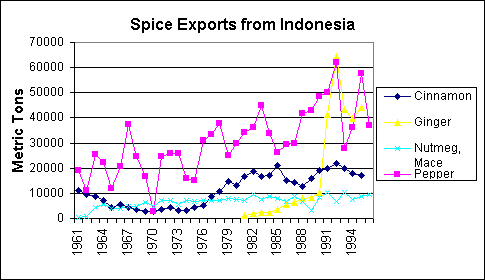
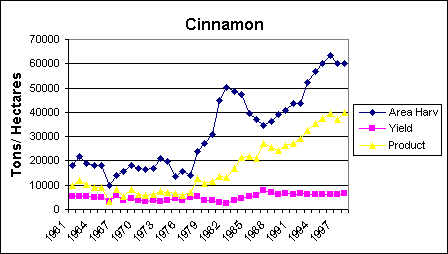
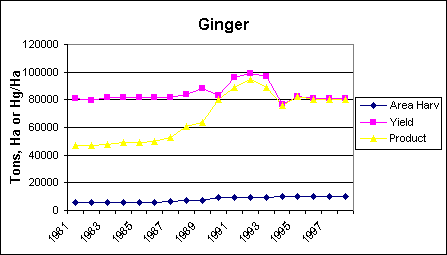
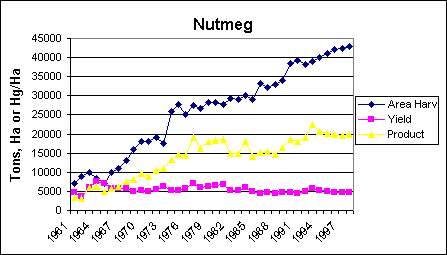
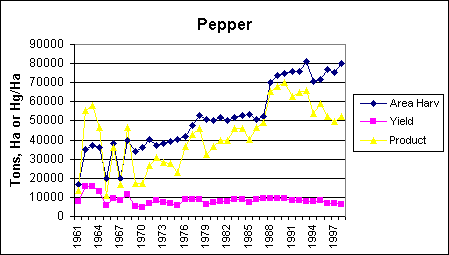
Source for all graphs: FAO Statistical Database
These graphs indicate that there is potential to increase yields in pepper, nutmeg, and cinnamon. Ginger, on the other hand, has seen yields move generally at the same rate as production, as acreage has remained relatively flat. Thus, for the purposes of this paper, the crops of pepper, nutmeg, and cinnamon will be examined. Ginger may provide an opportunity, and deserves further study, but does not meet the criteria of being at an early stage in agricultural transition. To understand the dynamics and possibilities for each of these spices, it will be helpful to have a brief explanation about where they are grown and some of the history behind their development.
Cinnamon
There are several varieties of trees in what botanists call the "cinnamomum"
family. Most of the cinnamon used in the U.S. is derived from trees of
the "cinnamolnum cassia" division of the family, which is why cinnamon
is sometimes referred to as cassia. Among spice experts, this term is used
to distinguish between the cassia types of cinnamon and the Ceylon type
of cinnamon. The cassia group is native to China, Indo-China and Indonesia.
They produce the product most Americans recognize as cinnamon -- a reddish
brown powder with a strong characteristic aroma and flavor. Quite
different from these are the Ceylon and Ceylon-types of cinnamon. The
products in this case are characteristically tan-colored, with flavor and
aroma much milder than that of cassia that the average person in the U.S.
would consider
them weak or poor cinnamon. Most Ceylon cinnamon brought into the U.S.
is re-exported to Mexico, where it is preferred for certain confections.
In labeling, however, bark from the cinnamomum family (whether cassia or
Ceylon-type) may be called "cinnamon."
The most commonly used cinnamon in the U.S. comes from the cassia type of cinnamon trees, for which there are three main producing areas. Indonesia supplies two types: "Korintje" and "Vera" (or "Batavia"). China, now that the U.S. has resumed trade with that country, is an increasingly important source. Vietnam is the third producing area, (known for "Saigon" cinnamon).
Indonesian cinnamons (cassia) come from the mountainous areas inland from the port of Padang on the island of Sumatra. The highest concentrations of essential oil in Korintje and Vera are found in the thicker bark on the lower parts of the trees. The grade designations for both cinnamons are "Quality A": (quills must be one meter long, taken from the main trunk), "Quality B": (from the side branches) and "Quality C": (broken pieces). Coming from a higher altitude, the Korintje cinnamon characteristically has a slightly more intensive color and flavor than the Vera and is thus rated the better type. In general, Korintje is deep reddish brown and has a sharp cinnamon flavor; the Vera is lighter in color.
The U.S. is the largest importer of cinnamon, and imports have been rising gradually, especially since 1982. The average annual volume of cinnamon world trade is 35,000 tons. In the wake of the recent financial crisis and adverse weather conditions, cinnamon was an alternative crop that Indonesian farmers turned to when faced with devastated rice crops and the devaluation of the rupiah. This increased production drove export prices to 40 cents per pound in 1997, down from 80 cents per pound in the same period of 1996. This is likely a short-term phenomenon, however, as the effects of El Nino subside and supply of cinnamon returns to levels more commensurate with demand.
Nutmeg and Mace
Nutmeg is the seed of the pala fruit tree, found close to the sea in
well-drained areas of some tropical islands. The seed is partially
covered by a thin red membrane that when removed and dried becomes the
spice called mace. Both are enclosed within a hard shell inside the
fruit. Indonesian nutmeg and mace are grown on the islands of Sian and
northern Sulawesi, and the processing center is in Menado. Smaller amounts
are grown in Maluku, Aceh, West Java, Irian Jaya, and West Sumatra.
Most of the East Indian product today arrives in the U.S. cracked and cleaned,
ready to be ground (whole nutmegs cannot be fed directly into a grinding
system). Indonesian nutmeg is highly aromatic, with a distinctively characteristic
bouquet. It tests high in steam volatile oil, but not as high (as the West
Indian) in fixed oils, making it an excellent choice for grinding and use
in the ground form.
Indonesia produces more than three-quarters of the world's output of nutmeg and mace, and has been the world's dominant source of these spices for hundreds of years. In 1986, the Indonesian government introduced export regulations that facilitated cartelization of the market, and prices of nutmeg and mace on the world market increased dramatically. These regulations allowed exports only by approved traders, who were members of ASPIN (Asosiasi Pala Indonesia), and required exports to be coordinated and restricted by the ASPIN marketing board. Subsequently, a cartel agreement was made with Grenada, which exports 20% of total world nutmeg exports. Problems such as accumulation of unsold stocks and smuggling of nutmeg and mace through Singapore led the Indonesian government to abolish the regulations in 1990. Other goals of the deregulation were to create greater business opportunities, raise farm productivity, and diversify the market.
Since deregulation, prices of nutmeg and mace have dropped drastically, and now Indonesia earns only about $7 million in export revenues compared with more than $42 million in the late 80s. Because of this, there is a temptation to return to regulations like those in effect from 1986-90. Indonesian nutmeg and mace exporters have repeatedly called for reregulation, not surprisingly, since they benefited the most from the controls through increased prices. Although farmers did receive an increase in revenues, from approximately Rp 500 per kilogram in 1985 to a high of nearly Rp 4000 in 1988, exporters and foreign traders earned much more. Exporters' margins went from about Rp 2000 to Rp 9000, while foreign traders' margins increased from just over Rp 2000 to Rp 12,000. Additionally, the control of supply was at the exporter level rather than the farmer level. This created a situation of exporter monopoly power over both foreign buyers and domestic sellers, and farmers continued to accumulate unsold stocks. It was costly to produce output and not sell it, so smuggling became an alternative outlet for excess nutmeg and mace supply. Also, as prices increased on the world market, demand for exports declined, but the decreased demand never influenced farmer production. This is partly due to the nature of nutmeg production, which is highly inelastic. There are only a few crops to substitute for nutmeg, and it is difficult and costly to switch to new crops. Also, limited availability of rural credit makes it difficult for farmers to withhold supplies in response to price falls.
The return to regulated nutmeg trade is not probable, especially in light of the Uruguay Round Agreements in 1997. One part of these agreements was the Agreement on Agriculture, which lays the foundation for reducing distortions in agricultural trade and for the gradual establishment of a fair and market-oriented agricultural trading system. Additionally, according to Article 11 of the Agreement on Safeguards, "spice-producing countries will no longer be able to resort to minimum export prices and voluntary export restraints or to form cartels and associations for the purpose of imposing such measures" (International Trade Forum, 1/12/97). Thus, to ensure positive development of international trade, it is unlikely that the cartel will be reestablished.
About 12,000 tons of nutmeg and mace are traded annually, with the United States as the largest single importing market. Recently, the price of nutmeg has soared from Rp 2500 to Rp 140,000 per kilo, due to a resurgence in global demand for the spice, combined with the weaker rupiah. Consumption is generally steady in the United States, but rises in October through December as seasonal usage comes into play. New uses, such as aromatherapy oils, perfumes, and essential oils used as food flavorings may help to boost demand.
Pepper
In terms of both volume and value, pepper ranks as the main spice in
international trade. Historically, pepper has been one of the most sought
after spices of the Orient, and the island of Sumatra produced a considerable
supply. Pepper was valuable not only for its ability to flavor food, but
also for its preservative qualities. In 1805, Indonesian pepper exports
reached a level of 7 million pounds; in 1997 the U.S. imported 41,602 tons
of whole black peppercorns. Of this, India supplied 44% and Indonesia
41%. The U.S. is the largest market for pepper, accounting for 25%
of world trade. Total would trade amounts to $564 million or 140,
000 tons.
Pepper in Indonesia is principally grown on the island of Sumatra, a major producer of fine quality black pepper. Cultivation is centered in the Lampong district of southeastern Sumatra and shipments are made from the port of Pandjang. This pepper compares with pungency and flavor, testing high in steam volatile oil and non-volatile extract. Pepper is commonly intercropped with other cash crops, such as coffee and tobacco. Although the income per hectare is higher for perennial plants such as pepper, it takes many years before these plants bear fruit. Farmers have to wait five years before they begin to harvest. Pepper also requires a large initial investment in seedlings, supports, and fences, plus the opportunity cost of a perennial crop with delayed yielding.
Pepper demand has experienced steady growth of about 4% in the past several years. Increased purchasing power throughout the 1980s in some Middle East and North African countries gave rise to sharp increases in pepper consumption. The U.S.' demand has also risen, from 60.5 million pounds in 1985 to 78.5 million pounds in 1995. Recently, there has been a surge in prices for pepper due to increased demand, damaged crops caused by El Nino weather conditions, and looting in Indonesia. According to one supplier, "raw material pepper prices have reached levels never before experienced." (Chemical Market Reporter, 7/28/97) According to the International Pepper Community, "world pepper demand will continue to outstrip supply for the next 10-15 years." (The Financial Post, 3/7/97) The 800% increase in prices from 1997 to 1998 forced a shake out of Indonesian pepper exporters, from 42 to 8 companies. The huge working capital needed at the farmer level weakened the purchasing power of exporters, and forced many of them out of business. Those farmers who have maintained production are gaining substantially, earning Rp 43,000 (US$4.30) per kilogram versus Rp 5000 (US$2.00) a year ago.
Recommendations
The islands of Indonesia hold a comparative advantage in spices which can be exploited as the demand for spices rises in the U.S. and other developed economies. In addition to their role as a foreign exchange earner, spices can act as a stimulus for rural growth. Spices are generally suitable as a smallholder backyard crop, as is the case for the majority of spices grown in Indonesia. Furthermore, spices can be cultivated on slopes and other marginal lands that are unsuitable for other crops. This makes many spice crops an excellent secondary crop, and perfect for intercropping with crops like coffee. Spices and essential oils offer further advantages of being relatively low volume, long-storage items, important in Indonesia's more remote areas where transportation is limited.
The potential for value-added exports, including grinded spices, essential oils, spice mixtures, and oleoresins is growing for some spices, as shown by the increasing demand from developed countries. By adding value before export, Indonesian farmers could gain a more substantial portion of the end value of the product. Possibilities include development of oil distillation plants, grinding facilities, and seminars to discuss new end-uses for spice products. One example of value-added processing has occurred in Grenada, which has established a nutmeg oil distillery. This made economic sense, in light of the fact that nutmeg oil has experienced increasing demand, while demand for whole raw nutmegs has not grown. The distillery can also be used to make oil from mace, cinnamon, and clove, offering further diversification for Grenada's spice sector.
The possibilities for adding value go beyond simple processing. Production of soaps, lotions, shampoos, and food items with essential oils would integrate the rural and manufacturing sectors, a relationship that has been limited in Indonesia thus far. Further usage of spices downstream into end products could create larger manufacturing opportunities, but would also require more sophisticated marketing and manufacturing facilities than do raw commodities. It should be pointed out that adding value may make sense for some spices and not for others. The value of some spices in their raw state makes it less worthwhile to invest in the processing and manufacturing facilities needed for end products. To determine the possibilities, each spice should be considered individually. Nutmeg oil, for example, is used by many food manufacturers in meat products and bakery goods. It is also used to manufacture perfumes and to an extent in the pharmaceutical industry. In general, the demand for products and scope of usage should be determined prior to investment in value-added processing.
The maintenance of quality and safety of spices is of prime concern to the spice industry. Care must be taken in harvesting and handling of spices so as to prevent microbiological contamination. Especially in the industrial sector, a niche of spice trade that is important for export expansion, the confidence of the user in quality and safety is crucial. Quality assurance needs to commence at the farm and follow through to exports. This can be done through adoption of appropriate post-harvest handling methods, adequate storage facilities, and suitable packaging. India provides an interesting case for improving the quality and marketing of spices. The Spices Board of India assists farmers in meeting quality standards, as well as teaching better methods of harvesting. Training programs have been conducted to educate farmers about quality improvement at the farm level, quality requirements of importing countries, and quality testing before shipment. The Spices Board extends its assistance to exporters as well, by establishing processing and cleaning units and small laboratories for quality testing. Warehouses and sophisticated cleaning plants have also been built near the ports or marketing centers as a common facility. To facilitate spice marketing, the Board has created a logo as a mark of quality assurance for exports of spices in consumer packs. The logo ensures that spices have undergone physical, chemical, and microbial examinations, as well as tests for pesticide residues. Wide publicity is being given abroad to the logo, so as to create a demand for quality-assured Indian spices.
Quality assistance programs such as this would encourage diversification into spice crops by smallholder farmers, especially if they are given information on how to cultivate crops with a higher world market value. Additionally, a combination of subsidized plant material, assistance with fertilizers and pesticides, and ongoing research on more sophisticated farming techniques would help to boost yields. One program instituted by Grenada's Ministry of Agriculture is an agreement to encourage proper farming techniques. The farmer signs a loan agreement for the plant materials, and if he cultivates the land according to instructions, his loan is converted into a grant. Two spice specialists work along with the Ministry's 20 regular agricultural extension officers to help farmers with spice cultivation. Extension services such as these, which work closely with farmers to cultivate desirable crops and to teach them cultivation techniques, would create a supply of highly valued crops while also increasing yields.
A final recommendation includes cooperation and sharing on an international
level. Both India and the Caribbean islands have done considerable
research on alternative uses for spices. The Indonesian government,
through agencies like the Indonesian Pepper Exporters Association (AELI),
could work with these countries to understand developments in spice usages,
as well as improvements in cultivation techniques and plant material.
Although some countries may cultivate competitive products, limited collaboration
may help to grow the entire spice category worldwide, thus benefiting all
involved.